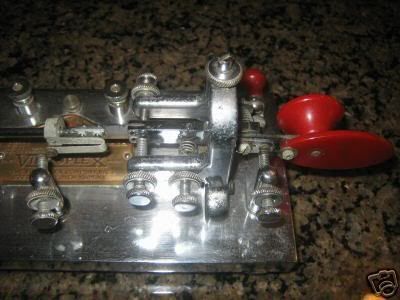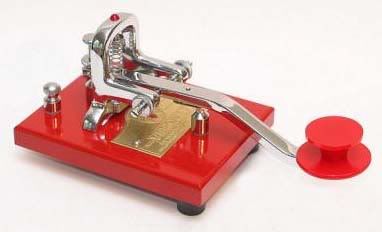Yeah, maybe I'm being too much of a fussbudget about it, but how hard is it to properly pack something for shipment??
After gleefully breaking my own campaign promise of “No New Vibroplexes,” I was disappointed to find an eBay seller had packed 1945 Vibroplex Original DeLuxe in shredded paper. Now you might be able to ship things that don't have much mass to them in shredded paper, but a Vibroplex key is NOT in that category.
The things weigh roughly 4 pounds, and that much steel in a small box — without adequate packing — means you have a 4 pound paper compactor. The sheer weight of the key bouncing inside the box will pack wadded newspaper, shredded paper, and an inadequate number of foam peanuts into the ends or the corners of the box. Each time someone handles the box — and tosses it into the next bin — it bangs around again, nearly with the force of dropping it on the floor.

I hate thumping boxes, and that's what I felt when I picked up this USPS Priority Mail box. Anytime a key is loose in the box, its bad news.
In this case, the bad news wasn't the worst I've had — the red thumb piece was shattered and the keying lever was forcibly knocked out of place. The red paddle is a $7 item I can buy new, the pivots can also be replaced. Only one was damaged, and I think it'll be OK. The only damage that happens to the pivots in shipping is when the keying lever is forced out of place. Inside each pivot screw is the synthetic “jewel” the lever shaft rides on. There is a small lip of metal that surrounds the “jewel”, and when the lever is forced out of place, this lip is usually damaged. The result is the keying lever won't stay in place because the lip is gone in one place.
I've found that in most cases, a damaged pivot screw can be salvaged simply by adjusting it 1/4-turn to the left or right. Since the lever has weight on the far end of it, the forces on the lever at the pivot point generally are in parallel to the lever. As long as that lip on the pivot screws is mostly intact — and you rotate the damaged area to the left or right of the main lines of force on the lever, the keying lever will work without a problem.
I've had a couple of pivots that were damaged beyond salvaging, but most can be salvaged.
Back to the key. It isn't immaculate or mint, or even near-mint. But it's a fine example of the late WWII Vibroplexes. The seller listed the chrome as pitted, but its my experience that many of the chrome parts, particularly the pivot frames, were just poor quality from the beginning.
This didn't mean they didn't work, but they quality of the castings just didn't equate to the same quality we have from Vibroplex today.
The key operates fine, and it is a fast key. It's amazing how much variance you find in some of the keys. Sometimes I wonder if it boils down to use — a much-used keys' mainspring loses some of its “spring” over time. Or maybe its just the spring steel they were using for the keys changed.
I have successfully glued the pieces of the red thumb piece back together. Not a pretty sight, but even it beats not having a paddle on it.
SPEAKING OF VIBROPLEX …
I guess Vibroplex's latest new key made its debut at the Dayton Hamvention … the Know Code Key. I assume it is aimed at both the collector's market and the CW Forever guys, and probably the newer hams who want to pursue CW.

It's basically Vibroplex's regular straight key with a red painted base rather than black base, priced about $30 higher than the base straight key. Special too for the Know Code Key is the serial number plate — which says “Know Code” to the left of the Vibroplex bug logo, and a special Know Code “KC” serial number on the righthand side.
I've always wanted to try a Vibroplex straight key, but they usually sell on eBay for a premium. I like straight keys, but I'm not willing to go that much for a key I'll probably not use much. I haven't used a straight key for a contact in ages, so I don't know that I'll be buying a new Know Code key. I might alter that statement if I have an opportunity to try one and like it.
One of the nicest straight keys I've been playing with lately is a WWII Luftwaffe key I received a long time back as part of an eBay auction of related CW junk. I found it recently have cleaned it up and took time to adjust it. I was surprised at the precision feel the old key has. The key originally had a metal cover, but this key was long separated from the original base and cover. It's just the plain key, but it did come with the original WWII-vintage cloth-covered key cable. I think they used some form of gutta percha or other rubber for the insulation, its some unusual stuff, particularly when you're used to synthetic insulation.
Back to the topic of Vibroplex. I really love the bugs and the history, and I think there are opportunities for the company to create some products for the collector crowd.
There are several models that they could bring back in limited numbers; for example, the Lightning Bug, which is less expensive to build than the Original (no castings, just stamped steel parts). I suspect there would be a lot of interest among collectors in the old Line Chief's key, the Vibroplex Vertical bug. However something tells me the vertical key failed because telegraph operators just didn't like the way it performed. Would a nostalgia version sell today — even if its performance wasn't the greatest? The bigger question probably is this — would sales cover the cost of new tooling to produce the key?
A psuedo-version of the key is currently being produced by N4VIZ. He makes a vertical bug and also a 90-degree bug, both of which I would love to buy, and may eventually. The VIZ keys are nice, but they aren't quite as “finished” as Vibroplex keys. For example, instead of brass, a Vibroplex version would be chrome plated with painted finishes as required. I like the Viz keys, but Vibroplex could really make a nice key great — provided it was profitable. Is a new, limited edition key worth a collector's investment?
Another key the company could produce is the Vibroplex Midget. This key was the workings of a regular key on a narrow and thin base. A leg (or legs) swung out to provide stability. The Midget was a very short-lived key, probably again because it was never a practical key to use.
There are several other Vibroplex keys that fell by the wayside … the Double Lever key and the Model X, both interesting variations of the Original. The Model X was designed so it had a single contact point, rather than the two used in the Original and other bugs.
Of course, does Average Joe Ham give a flip about buying a new reproduction of historic CW keys? I don't know. The average Joe Newham probably has very limited interest in ever learning CW. That may change over time, but the heydey of CW is over, and has been for many years. As I've written before, now that it is no longer a licensing requirement, it now becomes more of an artform that people pursue for the challenge and enjoyment.
That's not a bad thing, but I'm not sure how it plays out for someone wishing to boost the revenue of a company that manufactures code keys.
I've got a CW net to hit tonight, so I'll ponder these and some of life's other Big Questions between now and then.
73 es cul … de KY4Z …. dit dit …
